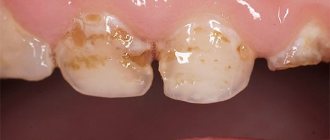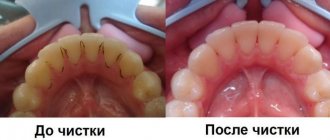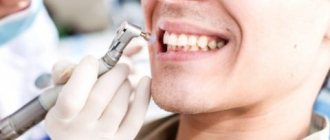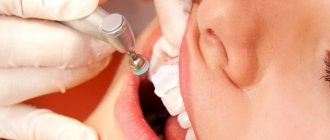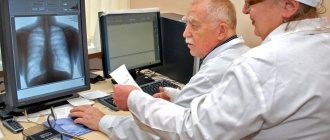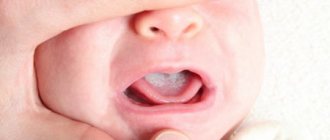The importance of oral hygiene
The health of our teeth and gums directly depends on proper oral hygiene. The importance of daily hygiene procedures is difficult to overestimate, but it is often easy to underestimate and pay with the loss of teeth even at a young age. So the statement of dentists that one of the most effective and at the same time simple ways to prevent dental diseases is proper and regular dental and oral hygiene in children and adults is more relevant than ever. We should not forget that hygiene procedures should not be limited to just brushing your teeth at home.
Preventive oral hygiene is a comprehensive measure that includes daily brushing of teeth and visiting a hygienist at least once a year. The fact is that in order to maintain teeth and gums in a healthy condition, it is necessary to promptly and efficiently remove dental plaque, as well as thick plaque on the tongue. Food debris and soft plaque can be removed with a toothbrush and toothpaste. But the removal of tartar (mineralized dental deposits) is carried out by a dentist using special means and instruments, for example, Air Flow. In this regard, comprehensive oral care implies individual and professional hygiene.
Selection of individual hygiene products
The main component of an individual prevention plan is compliance with the rules of oral hygiene, the effectiveness of which depends on the methods used. It is not enough to have a toothbrush, even a very good one, and excellent toothpaste. You need to be able to brush your teeth. Depending on the condition of the hard tissues of the teeth and gums, one or another cleaning method is chosen, the required hardness of the toothbrush is determined, and teeth cleaning products are selected. To illustrate, here are a few examples.
Each person should control the quality of teeth cleaning independently. The dentist evaluates the quality of teeth cleaning using special diagnostic staining agents (most often these are special tablets). And only if he is convinced that the patient can completely clean the teeth of plaque in a fairly short time (2-3 minutes), i.e. clean their chewing, external (buccal and labial) and internal (lingual and palatal) surfaces, as well as interdental spaces, which means he really knows how to brush his teeth.
Data from individual authors indicate that when brushing your teeth with a toothbrush alone, only 53% of dental plaque is removed, and only if the movements of the toothbrush are correct. Therefore, special attention should be paid to cleaning the interdental spaces. It is in them that plaque accumulates to the greatest extent and caries most often develops. To clean the interdental spaces, in addition to a brush, you must use a special dental floss - floss, the use of which is taught by a dentist. Flossing is usually done in the evening, after brushing your teeth with a brush and toothpaste.
The next stage is the selection of individual hygiene products.
The toothbrush should be made of artificial bristles (nylon replaced natural bristles back in 1938), combined into tufts, which are arranged in a certain way on the brush field. The head of the toothbrush can be of different sizes, but it is better to be small to ensure easy access to all parts of the oral cavity.
A quality brush will not have bristles that remain in the mouth when brushing. Unfortunately, approximately half of the toothbrushes sold in Russia today are low-quality counterfeits of products from well-known companies. In order to at least to some extent insure yourself against counterfeiting, you should buy brushes in stores and not in markets.
The toothbrush should be changed approximately once every 3 months, but if during the cleaning process the shape of the brush has changed or the position of the bristles of the head has been disturbed, it needs to be replaced earlier.
The stiffness of the toothbrush bristles should be selected individually, depending on the condition of the oral cavity.
When choosing a toothpaste, you should take into account that it carries not only a cleansing, but also a therapeutic and prophylactic load. 95% of currently produced pastes are classified as therapeutic and prophylactic.
Prevention of dental caries is largely associated with the use of fluoride. The maximum concentration of fluoride in commercially available toothpastes today is 1500 ppm (parts per million). The best foreign toothpastes contain 1200–1500 ppm of fluoride, while domestic ones contain slightly less. Fluoride-containing toothpastes are indicated for adults and children, but for children under 6 years of age, toothpastes with a lower fluoride content are recommended, because There is a danger of swallowing part of the paste, which can lead to the risk of fluorosis.
Patients must strictly follow the doctor's instructions for personal hygiene. But in addition to individual oral care, professional hygiene measures are also necessary, which are carried out by a dentist when a patient visits a dental facility. Only a dentist can remove dental deposits that cannot be removed with a toothbrush and tartar. Then he polishes teeth and fillings, and monitors the use of personal hygiene products by patients. Complete removal of plaque can prevent tooth decay and gum disease. This is a difficult task, and it can only be accomplished using special means, devices, instruments that the doctor has.
The number of visits for professional hygiene activities depends on the individual characteristics of the patient. Regardless of age, visit intervals can be 2 weeks, a month, or a quarter. The doctor’s prescription of a particular interval is influenced by the condition of the teeth, periodontal disease, and the patient’s ability to perform hygienic procedures.
For almost 50 years, fluorides have been used in medical practice and as topical agents. These are fluoride solutions and gels that can be used as rinses and in the form of applications. After a 4-minute application, you should not eat or rinse your mouth with water for 30 minutes. For people at high risk of developing caries, such applications are recommended once every 6 months.
Fluoride-containing varnishes are also widespread, the use of which is alternated with the use of solutions such as Romodent. At a high level of caries intensity, preventive procedures are carried out every month, at an average level - every quarter, at a low level - once every six months.
One of the important factors in maintaining dental health is proper nutrition. In some countries, a clear relationship has been established between the incidence of dental caries and the average amount of sugar consumption per capita. In groups of people with low sugar intake, the incidence of tooth decay is low, and vice versa. Sugar promotes the formation of acid in the oral cavity, which remains on the surface of the enamel from 20 minutes to 20 hours and participates in the process of its dissolution. Microbes in the mouth metabolize sugars such as sucrose and glucose into acid. In some countries, due to this, the consumption of sucrose is decreasing. Limiting sugar consumption is important not only for the prevention of dental caries, but also from a general medical point of view.
Currently, a relatively new food industry is successfully developing - the production of sugar substitutes and sweeteners that have a low potential for acid formation. The use of these ingredients in chewing gum is well known. They, firstly, stimulate the secretion of saliva and, secondly, contribute to faster neutralization of acids in dental plaque. This is the basis for the assumption of the benefits of chewing gum in reducing the risk of caries. Chewing gums can also be carriers of substances that in one way or another affect the condition of teeth, oral mucosa and the body as a whole. Along with sweeteners, these can be fluorides, which are also used in chewing gum.
Chewing gum can be prescribed as an anti-caries agent only to people who observe good oral hygiene. The main thing is, of course, brushing your teeth with a high-quality brush and toothpaste, and chewing gum can sometimes be used as an alternative in conditions where it is impossible to use a brush or it is not available (for example, during the day while working, at school). It is important to eat plenty of fruits and vegetables. If you need a snack between meals, you should not use sugary foods. You should never eat sweets at night, and if you eat sweets, you need to rinse your mouth with water or eat an apple.
American scientists have developed a method for assessing the influence of nutritional factors on human dental health, which involves keeping a food diary. They carry him on all week. The program analyzes diary entries. The validity of the doctor’s conclusions depends on the quality of the diary. If we are talking about a child under 12 years old, then this diary is filled out by the parents. This is essentially an example of dental nutrition analysis. By analyzing the quantity, quality and calorie content of food consumed, the time, frequency and duration of meals, the doctor is able to assess the potential cariogenicity of food products, which, in turn, allows you to select the most adequate individual methods and means of prevention.
Taking into account the above priorities makes it possible to increase the effectiveness of not only preventive measures themselves, but also dental care in general.
-The gum tissue is normal, the teeth are located tightly to each other in the dental arch.
A medium-hard brush is placed at an angle of 45° to the gum and with sweeping movements from the gum to the cutting edge of the front teeth and the chewing surface of the lateral teeth, they begin to clean: on the upper jaw - from top to bottom, on the lower jaw - from bottom to top (Fig. 1). Clean the upper and lower jaws separately, first from the outside, then from the inside, and then the chewing surface with anteroposterior and lateral movements.
-The gums are dense, but there are gaps between the teeth, there are enamel defects in the neck area, the latter are exposed.
A medium-hard brush is placed at an angle of 45° on the border of the gum and tooth. The bristles should be directed from the gum to the tooth. By lightly pressing on the brush, its bristles are moved into the interdental spaces, then several rotational movements are carried out in the horizontal plane around the axis of the bristle bundle. Consistently clean all interdental spaces from the chewing to the front teeth, alternately on the upper and lower jaw from the outside and from the inside. The front teeth are brushed with vertical movements of the brush from top to bottom in the upper jaw and from bottom to top in the lower jaw.
-The gums are inflamed, bleeding, swollen, and do not adhere tightly to the teeth (periodontitis).
A soft brush with bristles in 1-2 rows (extra rows are cut off) is placed at an angle of 45° to the border of the gum and tooth. Then the bristles are carefully deepened into the space between the gum and tooth and brushed with short movements in a horizontal plane (back and forth). Slowly pass all the teeth of the upper and lower jaws on both sides, then clean the chewing surface in the anteroposterior and lateral directions, and the front teeth are brushed in the vertical direction.
Individual oral hygiene
Individual oral hygiene is most effective if you follow certain rules on how to brush your teeth. As you know, there are many ways - each of them is correct and complete, it all depends only on our personal preferences. But it is still advisable to listen to the following recommendations from dentists:
- Always start brushing your teeth with the same row of teeth;
- adhere to a certain sequence of teeth cleaning so as not to miss any area;
- Carry out cleaning at the same pace in order to maintain the required duration of cleansing.
Of course, you need to pay attention to your teeth brushing technique. If, for example, you brush your teeth across the dentition, the enamel will wear off over time. Therefore, individual oral hygiene must be carried out in compliance with the technique of brushing teeth (you cannot even make circular movements - they must be perfectly round). But in our version they are more oval. Therefore, due to non-compliance with this important rule, the enamel by about 35 years of age is severely damaged, if not completely erased. However, if you use an ultrasonic brush, all of the above is not relevant for you. In addition, do not forget that cleaning the tongue with special scrapers is a necessary component of oral hygiene.
Irrigator
Irrigators are special dental care devices that deliver a stream of water under pressure. The nozzle allows you to direct the flow to a specific area of the dentition, removing soft plaque and food particles. When purchasing a tool, you need to pay attention to its characteristics. Today, there are stationary and portable irrigators for individual or family use of monojet, pulse type and microbubble technology.
We invite you to familiarize yourself with buy Miramistin, price for Miramistin in Moscow from 280 rubles, instructions for use, reviews.
Basic personal oral hygiene products:
- toothpastes, gels, tooth powders;
- toothbrushes;
- chewing gum (therapeutic and prophylactic).
It is recommended to choose toothpastes depending on the presence of certain problems or specific tasks. If you have had dental implants, your best choice would be toothpaste for implants. To lighten the enamel surface, you should pay attention to whitening pastes. But to strengthen teeth, restorative products are suitable, for example, Theodent or Swiss Smile Crystal toothpaste with theobromine.
There are also additional oral hygiene products. These include:
- floss (dental floss), toothpicks;
- oral irrigators (before choosing the best irrigator, be sure to study the main characteristics of the models);
- means for cleaning the tongue: scrapers, scraper brushes;
- Mouth rinses, oral deodorants, teeth whiteners;
- denture treatment powders/denture treatment tablets;
- foam for oral hygiene (foam dissolves plaque well and is indispensable where it is not possible to use standard oral hygiene products; just hold the foam in your mouth for 20–30 seconds and spit).
The unique, multifunctional device JETPIK JP200-Elite combines an electric sonic toothbrush, irrigator and dental floss. The components and the device itself are stored in a convenient plastic container, which is ideal for traveling or storing in a small bathroom.
Oral hygiene is important not only for the prevention of caries, but also for free, comfortable communication with others. Stained yellow teeth and bad breath will not make anyone attractive. Aesthetic dentistry procedures such as veneers and expensive laser teeth whitening will not make sense without basic hygiene procedures.
Publisher: Expert magazine about dentistry Startsmile.ru

